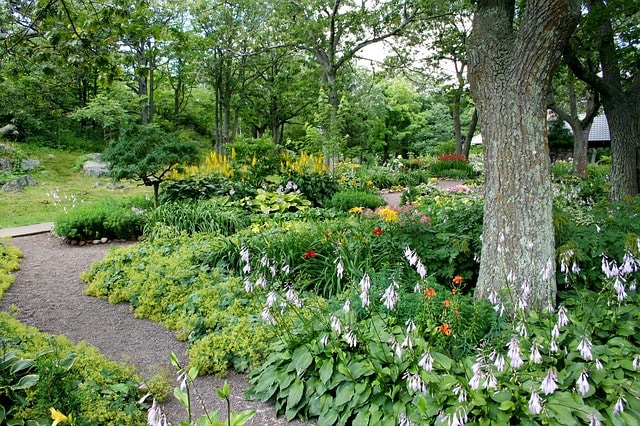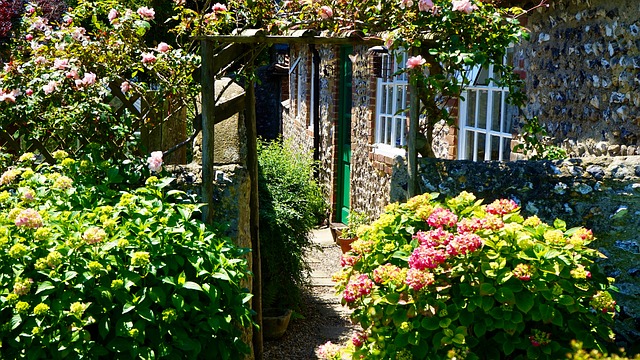Importance of Microclimate for Backyard Gardening

There are some basic tips that help turn your thumb green when it comes to starting a garden. One gardening buzzword that has been huge in helping me become a successful desert gardener is microclimate. When I began my gardening adventure, I had no idea what a microclimate was or anything to do with its importance. For those of us gardening in extreme conditions learning about microclimates makes all the difference.
What is a microclimate? A microclimate refers to a small area within a larger climate. A microclimate has its own distinctive climate that can vary from the general climate conditions. Typically when a gardener refers to a microclimate, it’s a small area within their yard.
Climate vs Microclimate
We all know about climate, which is simply the weather conditions for a given area, but microclimate takes it to another level. Think about the weather forecast for your city.
I live in the Phoenix Arizona area, which is a major city in the United States. When a general weather report is given, the temperature can fluctuate quite a bit in different parts of town, even though one general forecast is given for the entire city.
If rain is forecasted, which hardly is the case in the Phoenix desert, it’s not at all unusual for only certain pockets of the city to receive rain, while others remain dry. Taking this larger picture of how climate can vary so greatly just in a city, think about how climate can be different within your backyard.
A backyard here in Phoenix that is open and landscaped with rocks, can be quite different then the neighbor’s backyard with trees and a pool.
How can knowing your Microclimate help with gardening?
When planting in extreme climates knowing your microclimate can help you to plant things in the right spot to help them thrive. Our desert climate is zone 9b and has some very unique growing conditions. Since we stay relatively warm throughout the year it allows us the ability to grow tropical/subtropical types of fruit trees, but our cold snaps that occasionally go below freezing can cause problems.
We have plenty of sun, but too much of a good thing can also be death to a plant. We also have monsoons which bring intense winds. Various climates have a myriad of different conditions that can either help your plants to thrive or be detrimental without the right microclimates.
When you understand the needs of the plants you are growing along with your overall climate conditions you can begin to assess your current microclimates in your yards or what you need to create the right microclimate.
Things to Look for in a Microclimate

Your yard already has things that are exclusive to your yard versus your neighbors. As you take a look around your yard, there are a few key things to look for when finding the optimal microclimate for the fruit trees or edibles. Here are some things to consider when identifying your yard’s microclimate:
Sun Exposure
This is a big deal in our desert climate. Often times when you buy a plant or tree at one of the nurseries or big box stores these plants have a planting label on them.
When you read the label it usually tells how many hours of sun is needed a day or it will say full sun. Many of these labels are just generalized and not specific to your growing conditions.
For example, a blueberry plant label may say full sun, that may be well and good in the northern parts of the U.S., but that’s a recipe for a quick death in our desert sun.
You may be living in an environment where you get a lot of cloudy days, so planting something that needs sun under the shade of other trees doesn’t make sense.
Wind Protection
Winds can really thrash your trees and plants. Even worse, if you’re in an area where you get extreme winds like hurricanes, monsoons, or just strong storms, those winds can totally uproot your trees and plants.
In my climate, since we have very little humidity in the air, winds can have the feel of a blow drier in the summer. Planting things close together or next to a large tree can help create wind protection. Planting near walls or objects can make for wind barriers. Staking young trees also helps.
Humidity
If you are in a dry part of the world, a lack of humidity can be a challenge. Planting near water features like fountains, ponds, pools, etc., can help add a little more humidity. Planting more densely can also slightly help with humidity as plants leaves transpire.
Cold Protection
This is huge if you are trying to grow subtropical/tropical fruit trees or any other cold sensitive plant. Planting under eaves of the house and canopies of trees can make a big difference.
Again, densely planting trees together can help them keep each other slightly warmer. Objects like rock or concrete walls can help radiate some extra heat at night for warmth. Here is my complete guide for protecting tropical fruit trees in the cold.
Companion Planting
Planting things that thrive together can be beneficial in building your microclimates. I try to plant things like flowers and shrubs around the bases of my fruit trees to help bring in pollinators and create more dense foliage. It’s also is good aesthetics.
Creating the Optimal Microclimate
If you don’t have a yard with many of the optimal microclimates already established, then you can work to create some of those yourself. There are some things that you can do in the short term to create artificial microclimates as needed.
Shade Structure
Building a shade structure for some of your young trees or raised beds can be a solution to getting some instant shade. As your trees get larger, if they need ongoing shade, something more permanent will help.
It’s easy to make a simple shade structure using four large wooden stakes around the tree and using a shade cloth over top. It’s important that the cloth still allows some light in.
Frost Protection
Using the same structure used for shade can be converted into frost protection by using 6 mil plastic wrap around the structure and a sheet on top. You can simply just remove the sheet during the day for air flow.
Using Walls/Homes
I know there are a lot of concerns with planting trees close to walls and homes for structural integrity. It’s up to you to make that decision, but I have planted some trees fairly close to structures for protection.
Since most tropical fruit trees are slow growing and the growing conditions in my area aren’t optimal, it doesn’t allow the trees to grow as rapid or large as they would in the tropics.
So, I’m not as concerned with planting these types of trees close to my home or walls. Things that grow rapidly and large like a Mulberry, Fig, or Jujube, I personally wouldn’t plant them near my home.
Low Points in Yard
Keep in mind that cold air tends to sink. With that being said, those low spots in your yard can be great for things that need chill hours or can handle cold, but avoid those areas for your cold sensitive plants.
Low spots can also be issues for drainage. If you have plants that like a lot of water, plant in your low spots where water tends to pool up.
Other Trees/Foliage for Wind
Large trees are amazing for creating a microclimate for your trees. Planting fast growing trees or purchasing a property with some established trees can really help your microclimate.
If you think about a forest, those large trees usually shelter the smaller saplings below giving them the protection they need to get established. This is similar to how you can utilize your larger trees to help protect your younger trees from too much sun, wind, or cold.
In summary, if you are a beginner gardener, having a basic understanding of microclimates will help elevate your chances for success by understanding where to plant things in your yard.
If your yard doesn’t have the optimal microclimates for the things you are trying to grow, following some of the simple strategies can help create a better environment.
Please comment below on anything that you’ve enjoyed from this post or related to microclimates.
